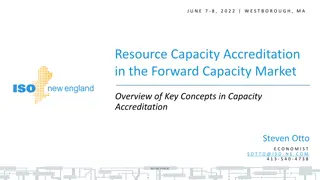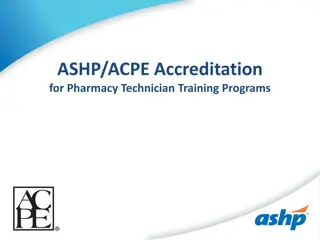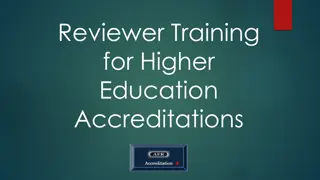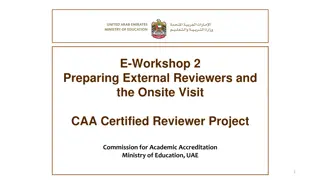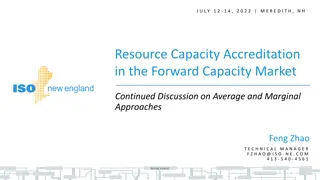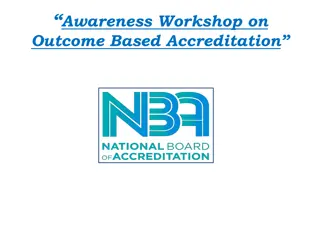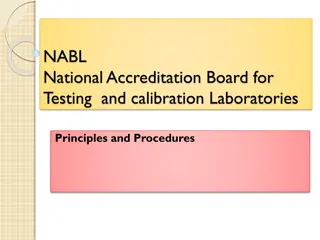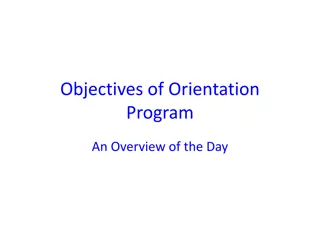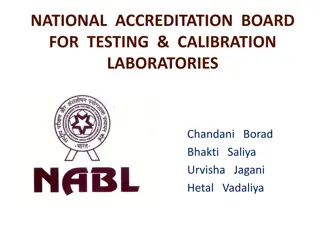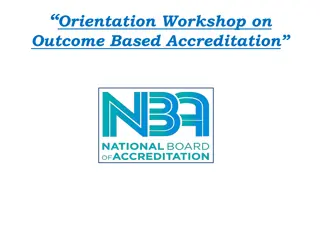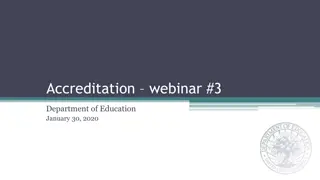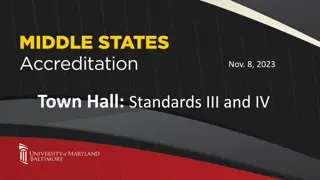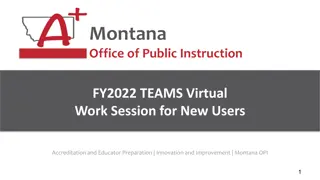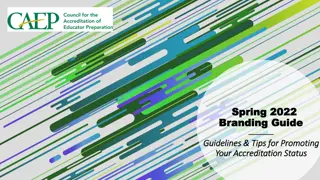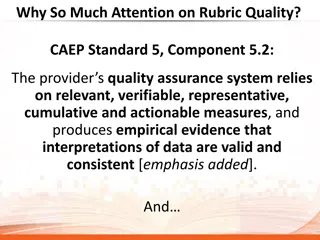National Accreditation (CAEP) Update
This content covers the National Accreditation Update (CAEP) at Lurie College of Education, San Jose State University, including an overview of CAEP standards, major changes in standards, and the alignment with CTC Common Standards. It discusses admission standards, program impact, and the ongoing revision process. The document also provides insight into the crosswalk between CAEP and CTC standards.
Download Presentation

Please find below an Image/Link to download the presentation.
The content on the website is provided AS IS for your information and personal use only. It may not be sold, licensed, or shared on other websites without obtaining consent from the author.If you encounter any issues during the download, it is possible that the publisher has removed the file from their server.
You are allowed to download the files provided on this website for personal or commercial use, subject to the condition that they are used lawfully. All files are the property of their respective owners.
The content on the website is provided AS IS for your information and personal use only. It may not be sold, licensed, or shared on other websites without obtaining consent from the author.
E N D
Presentation Transcript
National Accreditation (CAEP) Update April 3, 2015 Spring Retreat Lurie College of Education San Jos State University
Overview of CAEP CAEP Standards Overview How does it compare to NCATE? Major Changes CAEP Standard 3.2 CAEP Standard 4
CAEP Standards Standard 1: Content and Pedagogical Knowledge Standard 2: Clinical Partnerships and Practice Standard 3: Candidate Quality, Recruitment, and Selectivity Standard 4: Program Impact Standard 5: Provider Quality Assurance and Continuous Improvement
Major Changes CAEP Standard 3.2: Admission Standards Indicate That Candidates Have High Academic Achievement And Ability The provider ensures that the average grade point average of its accepted cohort of candidates meets or exceeds the CAEP minimum of 3.0, and the group average performance on nationally normed ability/achievement assessments such as ACT, SAT, or GRE: is in the top 50 percent from 2016-2017; is in the top 40 percent of the distribution from 2018-2019; and is in the top 33 percent of the distribution by 2020
Major Changes (con.) CAEP Standard 4: PROGRAM IMPACT The provider (LCOE) demonstrates the impact of its completers on P-12 student learning and development, classroom instruction, and schools, and the satisfaction of its completers with the relevance and effectiveness of their preparation. 4.1: Impact on P-12 Student Learning and Development 4.2: Indicators of Teaching Effectiveness 4.3: Satisfaction of Employers 4.4: Satisfaction of Completers
CTC and CAEP Revised Draft MOU (February 2015) Draft not yet signed Commission is working on alignment matrix for CAEP standards and CTC Common Standards o EPPs will still have to respond to CTC on any standards not covered in CAEP o Accreditation Advisory Panel is currently working on a revision of the CTC Common Standards
Crosswalk of CAEP Standards and CTC Common Standards CAEP Standard CTC Standard CAEP Standard CTC Common Standard 1. Content and Pedagogical Knowledge 9. Assessment of Candidate Competence 2. Clinical Partnerships and Practice 7. Field Experience and Clinical Practice 8. District-employed Supervisors 3. Candidate Quality, Recruitment, and Selectivity 5. Admission 6. Advice and Assistance 4. Program Impact No CTC Common Standard 5. Provider Quality and Continuous Improvement 2. Unit and Program Assessment and Evaluation No CAEP Standard 1. Educational Leadership 3. Resources 4. Faculty and Instructional Personnel
CAEP Process Submit self-study for off-site review which includes uploading evidence of meeting standards Post a call for public comment and distribute third party surveys Host a site visit Complete approved program review process for all programs of study leading to professional practice in school setting
CTC Process CTC still has sole responsibility for initial program approval EPPs will still submit program reports for program review process o CTC is working to streamline the program review process so that an extensive narrative is no longer required o Overview of less than 10 pages plus a matrix of where / how standards are met (i.e. courses, signature assignments, etc.)
CTC Response to CAEP Standard 3 EPPs that accept ONLY candidates with a BA/BS have met the selection criteria of high academic achievement and ability o Which is most of the programs in CA EPPs that accept candidates that have not yet earned BA/BS must provide data that it s cohort average meets or exceeds CAEP minimum requirements*
CTC Response to CAEP Standard 4 CA does not use Value-Added Measures as a statewide measure of teacher effectiveness o Therefore CA institutions can not be required to provide VAM data as part of joint CTC-CAEP accreditation EPPs must provide some other form of evidence that program completers contribute to expected student learning growth for CAEP accreditation
Areas of CAEP Standards Not Addressed by CTC Common Standards Standard 1 Content and Pedagogical Knowledge o Completers use research and evidence to measure student progress and own professional practice o Completers provide access to college and career ready standards (CCSS, NGSS) o Completers model and apply technology to design, implement, and assess learning Standard 3 Candidate quality, Recruitment, Selectivity o Recruit diverse candidates and address state and local shortages o Meet admissions criteria Selectivity at completion
Areas of CAEP Standards Not Addressed by CTC Common Standards Standard 4 Program Impact o Commission is developing / revising program completer and employer surveys that could be used to demonstrate meeting specific parts of this standard Standard 5 Continuous Improvement o EPPs assess performance against its own goals and standards, track results over time (Somewhat done in current CTC Program Assessments) o Measures of completer impact summarized, analyzed, and acted upon
Budget What impact will CAEP have on our current budget for accreditation?
Accreditation Costs AACTE: Membership: $8,000 (annual) NCATE/CAEP Membership: $5,000 (annual) CTC Membership (2015) $9,950 Site Visit (Every 7 years) : $6,000 costs for combined visit (food, housing, etc.) 7 Reviewers from CTC 6 Reviewers from NCATE
Preparing for Accreditation (budget) Assessment System: $ 40,000 Faculty Coordination: $ 89, 230 CAEP may require additional coordination, depending on how we (LCOE) propose to present program evaluations.
What programs outside of the LCOE are supported in our accreditation process? School of Social Work (PPS in Social Work credential) - College of Applied Sciences and Arts Adapted PE added authorization - College of Applied Sciences and Arts School Librarian - College of Applied Sciences and Arts
Resources: Informational and Technical Resources CAEP Accreditation Handbook to be released early 2015 Expectations for CAEP evidence Updated guidelines for completing self-studies Explanations for how quality assurance reviews will be conducted... ...Because CAEP also is committed to working with EPPs and with the field toward meeting the new standards, the handbook will be supplemented by a variety of activities and tools that will become available in 2015 and 2016.
Resources: Informational and Technical Resources CAEPCon Conference (Spring and Fall) Examples of Break-out Sessions: Measures of Teacher Impact on P-12 Students: CAEP Standard 4 (CAEP 101) Emerson Elliott, CAEP How educator preparation providers (EPPs) can demonstrate meeting CAEP Standard 4, including possible sources of evidence and/or aligned metrics.
Resources: Informational and Technical Resources CAEP Con Conference (Spring and Fall) Examples of Break-out Sessions: Common Metrics: Completer and Employer Surveys Mark Baron, University of South Dakota, and colleagues Presenters will share how 14 EPPs have collaborated to create, test, and refine common survey metrics for candidates at exit, completers after one year, and completers supervisors. Experience implementing these instruments and using data for program improvement will also be discussed and used to promote further dialogue.
Resources Technical Tripod Student Survey Adapted by CAEP Gathers student data on teacher effectiveness Jennifer E. Carinci, Director Research, Innovation, and Data Strategy 2015 Spring CAEP Conference
Resources Informational and Technical Resources CTC Accreditation Advisory Panel and Task Groups Task Group: Outcomes and Survey Data Review and redesign surveys based on changes in standards, make recommendations regarding useful reporting practices and formats, and standardize the use of this information in accreditation. Chair: Jon Snyder, Stanford Update: Program completer surveys: Two surveys have been reviewed, pared down and are ready to use in Spring 2015 - Preliminary Multiple Subject and Single Subject
Resources From Revised Draft MOU (February 2015), Next Step Opportunity to provide input The Commission staff will make additional revisions based upon the COA s discussion and gather feedback from California NCATE/CAEP accredited institutions to inform the next iteration of the agreement.
Nationally Accredited Universities Azuza Pacific CSU Northridge USC Cal Lutheran CSU San Bernardino UOP Cal Poly Chico State CSU Stanislaus LMU CSU Bakersfield CSU Dominguez Hills CSU East Bay Univ CSU San Marcos CSU Fresno CSU Fullerton CSU Long Beach CSU LA National Univ Point Loma Nazarene San Diego State San Jose State Univ Sonoma State Univ Stanford Univ La Verne Univ San Diego
Faculty Feedback From Fall Forum: Factors Influencing CAEP Decision Pro Con Agreement with CTC and professional organizations [Pending agreements] Task (selectivity, evidence on program impact) Improving programs Obtaining evidence, impact on enrollment Cost Budget (personnel, time) Continuous accreditation Tradition, marketing
Questions We Still Have ... Still looking for clarification from CTC on the MOU - looking forward to having that agreement signed so we know how to proceed How can we adjust our current exit surveys to meet our needs toward accreditation as well as better serve our students? As we prepare new reports for CAEP, how can we best use them to improve our growth as department / college? How might we need to adjust our assessment coordinator roles?
Timeline for LCOE Decision Faculty recommendation by late fall o More information should be available following CAEP Fall 2015 Conference Decision by end of 2015-2016 AY
Faculty Feedback Questions/Comments?








